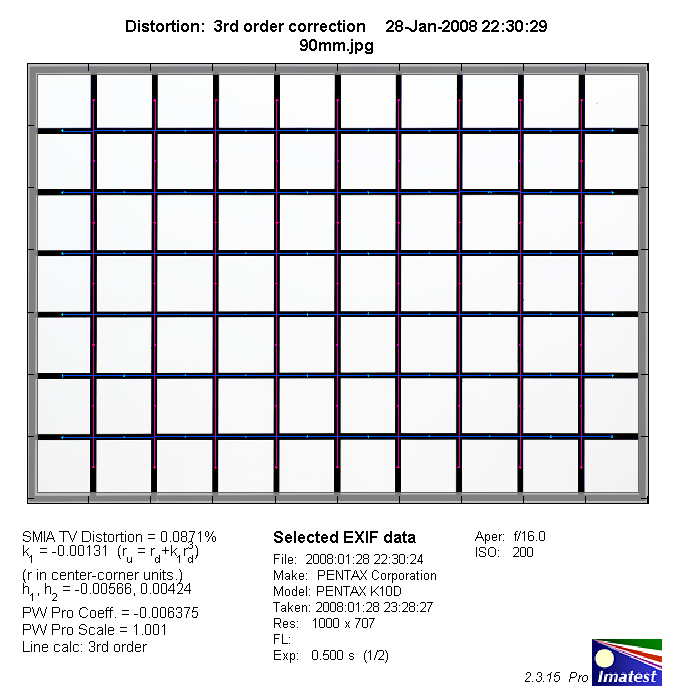|
Tamron AF 90mm f/2.8 SP Di macro (Pentax) - Review / Lab Test Report - Analysis |
|
Lens Reviews -
Pentax
|
|
Page 2 of 2

Distortion
Typical a medium tele fix-focal lens and especially from a macro lens the level of distortion is
absolutely negligible.

The chart above has a real-world size of about 120x80cm.
Vignetting
The Tamron is a full format lens and enjoys a sweet spot advantage when used on APS-C DSLRs.
At f/2.8 the lens exhibits only marginal vignetting (0.4EV) which isn't really field relevant anymore.
From f/4 & up the issue is absolutely negligible.

MTF (resolution)
Typical for most macro lenses the Tamron AF 90mm f/2.8 SP Di macro performed great in the MTF lab.
The lens is already very good to excellent at f/2.8 and it reaches its excellent peak performance
around f/5.6. Beyond f/8 diffraction is the limiting factor - a physical barrier where no smart
lens design can help. Generally you should avoid stopping down beyond f/16.
Please note that the MTF results are not directly comparable across the different systems!
Below is a simplified summary of the formal findings. The chart shows line widths per picture height (LW/PH) which can be taken as a measure for sharpness.
If you want to know more about the MTF50 figures you may check out the corresponding Imatest Explanations
Chromatic Aberrations (CAs)
Lateral chromatic aberrations (color shadows at harsh contrast transitions) are are generally well
controlled (around 0.6px at the image borders) and usually nothing to worry about.

Bokeh
The bokeh (the quality of the out-of-focus blur) is a major aspect for macro/portrait lenses because
it is often an essential part of a scene. As mentioned the Tamron is a very popular lens in this market
and part of its success story is also the smoothness of the produced bokeh. The blur is very uniform without
a significant preference for an axis (see the cropped portions of the cards below) and busy portions
(like the wheat) are handled very well. The circular aperture shape is reflected nicely in the out-of-focus
highlights. There's a slight outlining effect at the edges here though. All in all the lens lives up to
its reputation here.
When looking closely at the cards you may see some hints of longitudinal Chromatic Aberrations (LoCA) - these
are colored out-of-focus highlights (purple in front of the focus and green behind). It's not an excessive
problem at f/2.8 and less so at f/4 but it can be visible nonetheless.

Here're some full size samples taken at f/2.8, f/4 and f/5.6.
Verdict
The Tamron AF 90mm f/2.8 SP Di is an excellent lens without significant flaws and it is at least as
good if not even slightly better than its more expensive native Pentax counterpart. The resolution figures
are impressively high, vignetting is marginal and distortions are non-existent. There're hints of lateral
and longitudinal CAs but that's nothing out of the ordinary here. The bokeh (out-of-focus blur) is very
smooth so the lens is very well suited for shallow depth-of-field situations. The build quality is
decent. Taking the moderate pricing into account the Tamron represents an excellent deal.
| Optical Quality: |
 |
|
 |
| Mechanical Quality: |  |
| Price/Performance: |  |
| | |
| | |
|